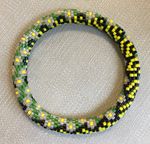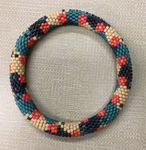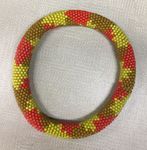Creativity and Rigor: A Bead Crochet Mathematics Course
←
→
Page content transcription
If your browser does not render page correctly, please read the page content below
Bridges 2021 Conference Proceedings
Creativity and Rigor: A Bead Crochet Mathematics Course
Eve Torrence
Randolph-Macon College, Ashland, Virginia, USA; etorrenc@rmc.edu
Abstract
In the fall semesters of 2018 and 2019 I taught a general education mathematics course motivated by bead crochet
for the Randolph-Macon College Honors program. The course is based on the book Crafting Conundrums: Puzzles
and Patterns for the Bead Crochet Artist by Ellie Baker and Susan Goldstine. The mathematical content of the
course and two of the most complex projects are described in this paper. Many images of student work are included.
Introduction
Crafting Conundrums: Puzzles and Patterns for the Bead Crochet Artist by Ellie Baker and Susan Goldstine
[1] contains a wealth of mathematical ideas for designing bead crochet bracelets. Topics covered include
topology, graph theory, the Four-color Theorem, knot theory, tessellations, and wallpaper groups. When I
first read this manuscript, I immediately thought this book would be a great way to introduce
interesting mathematical topics that most undergraduate students never get to study. At Randolph-Macon
College we have the opportunity to design and teach creative special topics courses in our Honors Program.
These courses have a limited enrollment of 15 and cannot require any prerequisites. They are primarily
taken by first- and second-year students and most of the students enrolled in this course were not
mathematics majors. In fact, some students selected this course because they had previously struggled in
traditional mathematics courses. Would it really be possible to introduce students to all these topics, have
them solve challenging math problems, and teach them to bead crochet, all in one semester?
Mathematics Motivated by Bead Crochet Design Challenges
Baker and Goldstine have extensively analyzed the challenges of bead crochet bracelet design using their
mathematical training. The nature of this medium is surprisingly complex. Understanding the bead crochet
designs in their book first requires an understanding of the fundamental domain and infinite plane
representations of a torus. This requirement motivated the introduction of some basic topology in the course.
The very first mathematically interesting bracelet Baker and Goldstine designed is a representation of
a map on a torus that requires seven colors to be properly colored. One of the best explanations of the map
coloring problem can be found in Robin Wilson’s acclaimed book [6]. Understanding this problem and this
bracelet design requires students to learn some graph theory. We also discussed the history of the Four-
color Theorem and learned partial proofs of the Four-color Theorem and the complete proof of the Seven-
color Theorem for maps on a torus.
Similarly, an understanding of basic knot theory is required to understand the design of bracelets that
represent torus knots. We also learned how to design figurative tessellations of the plane and torus starting
with simple tilings by parallelograms, triangles, and hexagons. We studied M.C. Escher’s wonderful
designs and the corresponding wallpaper groups as described by Doris Schattscheider in [5].
1Torrence
Two Projects: Snakes on a Plane and Escher Designs
The Snakes on a Plane project requires students to design a bracelet with a symmetric pattern that
approximates a torus knot. This project develops an understanding of the fundamental domain of a torus,
torus knots, slope, and symmetry. Figure 1 contains a variety of Snakes on a Plane designs by my students.
These designs are based on a (3, 2)-torus knot (i.e., a trefoil knot). A (P, Q)-torus knot circles the torus P
times through the center hole of the torus and Q times around the circumference. This project was inspired
by the Knotted Snakes design on page 159 of [1] but Knotted Snakes is based on a (4, 3)-torus knot.
The leftmost image in Figure 1 is the template we designed as a class for the Snakes on a Plane project.
Identifying the left and right edges of the rectangle forms a tube and connecting the top and bottom edges
of this tube forms a torus. Beginning with the bottom left corner and keeping in mind how the rectangle
represents a torus, it can be seen that the red line traverses the torus circumference twice and passes through
the center hole of the torus 3 times. The black landmark points show where a new repeat of the pattern for
the design starts.
(a) (b) (c) (d) (e) (f) (g) (h) (i) (j) (k) (l)
Figure 1: (a) Snakes on a Plane project template. Designs by students: (b) Sarah Meek, (c) Olivia Walker,
(d) Catie Leigh Deal, (e) Morgan Lindsay, (f) Ireland Seagle, (g) Sydney Koch, (h) Emily Cannon, (i)
Brianna Vallejo, (j) Ali Fay, (k) Connor Peak, (l) Peyton Humphreys.
Mathematical ideas needed to lay out this template include developing a coordinate system and deriving a
formula for the slope of the line connecting the landmark points. The biggest challenge is finding values
for the length L (measured in double rows of beads) and width N of the template that will form a reasonable
length and thickness for a bracelet while allowing a (P,Q)-torus knot design. The slope of the line for a
2Creativity and Rigor: A Bead Crochet Mathematics Course
(P,Q)-torus knot is (2LQ-P)/(P(2N+1)). This ratio must reduce to a fraction whose numerator and
denominator are not too large. Values that are too large make it difficult to keep track of the design. After
tinkering with the numbers, we came up with L = 69 and N = 10, which gives a slope of (2*69*2-
3)/(3(2*10+1)) = 273/63 = 13/3. The red line on the template has a rise of 13 beads and a run of 3 half
beads. The way beads stack in bead crochet necessitates measuring horizontal distance in half beads.
Once the template size has been computed and the landmark points plotted on the grid there is a wealth
of possibilities for creating a Snakes design. The design is required to have 2-fold symmetry so that the
pattern in color is a 180-degree rotation of the pattern in white. This is a challenging exercise in symmetrical
thinking. After designing their patterns on paper, students used a beta version of Kiko bead crochet
software, designed by Ellie Baker [2], to create a nice image of the template for their design as shown in
Figure 1.
(a) (b) (c) (d) (e) (f)
(g) (h) (i) (j) (k) (l)
Figure 2: Students’ Escher Designs: (a) Elephants by Bekah Polen, (b) Leaves by Devin Teri, (c) Cats by
Ireland Seagle, (d) Creepy Crawlers by Kate Harrington, (e) Dinosaurs by Jessica Huck, (f) Faces by
Aubrey Rowe, (g) Elephants by Ali Fay, (h) Birds by Michelle Muratore, (i) Bees by Kendall Dowdy, (j)
Seahorses and Rays by Sarah Meek, (k) Ice Cream by Olivia Walker, (l) Chameleons by Morgan Lindsay
3Torrence
The goal of the Escher Design project is to create a bracelet with a tessellation design with a recognizable
motif. These designs are created in what Baker and Goldstine call the bead plane. This grid of circles can
be seen in the designs in Figures 1, 2, and 3. It represents sections of an infinite plane of beads and mimics
the way rows of beads stack in bead crochet.
A bead crochet design must be doubly periodic, and follow other rules, to form a continuous pattern
on a bracelet. The number of beads in a row, as well as the total number of beads in a single repeat of a
pattern, dictate the size of the fundamental domain of a pattern. These numbers also limit the size and shape
of the parallelograms, triangles, and hexagons that can tile the bead plane. Hence there are many limitations
on the tilings that can be used as a starting place for creating a figurative tessellation in bead crochet.
Designing a recognizable figurative design within all these restrictions is very difficult.
Students were allowed to use from 9 to 13 beads per row in their design. A longer row creates a wider
canvas and offers a higher resolution for the design, but it is more work to crochet. Most students started
this project by playing with designs in the Kiko software rather than starting with a basic tiling of the plane.
Some were able to create wonderful designs this way. But most students did not have success with this free
form method and soon realized it was easier to use transformations of a simple tiling of the bead plane to
create their design.
Figure 2 shows some of the students’ designs and their finished bracelets. For each design, I have
included enough of the bead plane to make the motif clear. I have also outlined one complete repeat of each
pattern. The variety in the number of beads per row and in each pattern repeat can be seen in the varying
size of the outlines. Designs (a) – (c) in Figure 2 are all based on the hexagonal tiling labeled (a) in Figure
3, while designs (d) – (f) in Figure 2 are based on the based on the parallelogram tiling labeled (b) in Figure
3. Design (h) in Figure 2 is based on the hexagonal tiling labeled (c) in Figure 3 while design (i) in Figure
2 is based on the hexagonal tiling labeled (d) in Figure 3. The other students’ designs are based on more
irregular tilings developed by trial and error.
(a) (b) (c) (d)
Figure 3: Several tilings of the bead plane by hexagons (a, b, c) and parallelograms (d and e) with
outlines of a single pattern repeat
Learning to Bead Crochet
An important objective of the course was to have all students learn how to crochet the bracelets they
designed. Bead crochet bracelets are made with very small glass beads that are strung on thread and then
crocheted with a tiny crochet hook. Learning this craft is challenging and takes a lot of practice. Most of
the students in this course had never crocheted before. I provided all the tools and supplies needed for all
the projects in the course. In the very first class we started by crocheting simple chains of yarn with large
crochet hooks.
4Creativity and Rigor: A Bead Crochet Mathematics Course
The first bead crochet project we completed was the seven-color torus made with large plastic beads (called
pony beads) and yarn as described in [3]. Goldstine has created tutorial videos for this project that are very
helpful for beginners [4]. Working with large beads makes it easier to learn the basic bead crochet stitch
and see mistakes. Spotting mistakes is an important part of learning any craft. The result of this project is a
model of a map on a torus that requires seven colors to be properly colored. Every region touches every
other region along an edge. This project also gives every student a torus that can be used for studying other
concepts throughout the course.
Over the 14-week semester students completed 3 bracelets with smaller and smaller beads. The first
bracelet used size 8 seed beads, the second used size 11 seed beads, and the third used size 11 Delica beads.
Beads sizes are numbered so that larger numbers represent smaller beads and Delica beads are smaller than
seed beads.
The first bracelet they made was the Trefoil Dissection pattern on page 160 of [1]. This bracelet is a
model of a (3,2)-torus knot. This bracelet was crocheted while working on the Snakes on a Plane project
and is a helpful model for learning about torus knots, as well as an attractive mathematical fashion
accessory.
The second bracelet was a design of their choice from [1] in size 11 seed beads. This gave them practice
with smaller beads, allowing them to improve their skills before tackling the even smaller Delica beads.
The final bracelet was their Escher design in size 11 Delica beads. Delica beads are cylindrical while seed
beads are round. The cylindrical beads give a more regular and flatter surface for the Escher designs. As
can be seen in the bracelet images in Figure 2, my students were able to produce nice results by the end of
the semester.
Most bead crochet practice was done by students outside of class. Students often came to office hours
to get help with this skill, but class time was almost exclusively dedicated to learning mathematics. Students
learned to bead crochet at different speeds and the students who picked it up more quickly helped the other
students. The students often met in the evenings for crocheting sessions.
This is not to say that learning to bead crochet was easy for all students. The most difficult parts of
making a bead crochet bracelet are starting the tube and closing the bracelet. There were several students
who never learned these skills and needed me to start and finish their bracelets for them or watch them do
it while sitting with me. But I was happy to work with them as they improved their skills.
One student had a severe vision disability. I was able to accommodate her disability by having her use
larger beads and a crafting magnifying glass worn around the neck. While this allowed her to successfully
complete the course, she was disappointed in the results of her projects.
Conclusions
I greatly enjoyed teaching this class, despite the considerable time required to develop the assignments. I
was lucky to be able to teach the class two years in a row and reuse my materials. Honors courses are
typically only offered once, or only repeated after several years. There is a high demand to teach these
courses across the college and in the mathematics department. The Honors program spotlighted this course
in its advertising materials as an example of the uniqueness of Honors courses. The class was in high
demand and had the maximum enrollment of 15 students both terms.
I was extremely pleased with how well the students learned the complex mathematics in this course,
the level of crochet skills they developed, and especially the creativity of their designs. Student assessment
was based on two exams on mathematical concepts, including proofs, and mathematics and design
assignments. Instead of a final exam, they gave presentations explaining how they developed their Escher
designs.
5Torrence
The course evaluations were very positive with students describing the course as “interesting,” “engaging,”
“different,” “intellectually stimulating,” “hands-on,” “unique,” “fun,” “challenging,” “a lot of work.” They
found learning to bead crochet integral to the course. “Learning how to bead crochet was the most important
because it allowed me to engage with the math and arts simultaneously.” “I loved seeing the mathematics
in action in the bead crochet.” “Mathematical theory = a new hobby.”
One mathematics major, Emily Cannon, audited the first offering of this course in 2018 just for fun.
As part of her senior capstone project the following year, Emily designed and crocheted several pieces of
jewelry. The set includes a long necklace showing successive iterations of the Sierpinski triangle and a
choker showing iterations of the Cantor set. Emily’s pieces, “Beaded Jewelry Set with Fractal Step
Designs,” were accepted for the 2020 Bridges Art Exhibition, see Figure 4.
Figure 4: Beaded Jewelry Set with Fractal Step Designs, by Emily Cannon
Acknowledgements
The author thanks Ellie Baker and Susan Goldstine for their endless help in designing this course, teaching
me how to bead crochet, and inspiring me with their wonderful book.
References
[1] E. Baker and S. Goldstine. Crafting Conundrums: Puzzles and Patterns for the Bead Crochet Artist.
A.K. Peters/CRC Press, 2014.
[2] E. Baker. Kiko bead crochet design software.
[3] S. Goldstine, S. Sommer, and E. Baker. “Beading the Seven Color Map Theorem.” Math Horizons,
vol. 21, no. 1, 2013, pp. 22–24.
[4] S. Goldstine. Bead Crochet Tutorial videos. https://www.youtube.com/watch?v=S81yZ0g1bP4
[5] D. Schattschneider. M. C. Escher: Visions of Symmetry. Harry N. Abrams, 2004.
[6] R. Wilson. Four Colors Suffice: How the Map Problem was Solved. Princeton University Press,
2004
6You can also read



























































